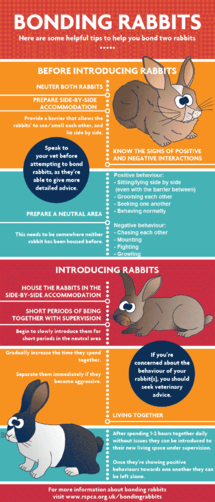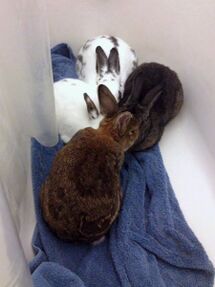Bonding rabbits together
Rabbits are highly social animals and ideally should be kept in pairs. However, a single rabbit is possible given that the owner be prepared to devote significant time to interact with the rabbit and provide companionship.[1] Additionally, while highly social, rabbits are also territorial and have a dominant-submissive social hierarchical nature, meaning an owner cannot expect any two rabbits to get along upon meeting. Bonding rabbits is the process of dating that allows rabbits to trust each other to live, sleep, eat, and play together without vicious territorial fighting and often takes a couple weeks to months.
Should I get another rabbit?

One of the main considerations before obtaining an additional rabbit is to be able to financially support more rabbits and make sure you have the ability to appropriately house rabbits separately in a safe manner for an extended period of time. While food, care, and litter bills will only incrementally increase, veterinary bills can make a sharp dent in your pocket and should be something that you will be prepared for, especially with certain breeds that may be predisposed to health issues. Rabbits will also likely take weeks to months to get along, and appropriately sized housing should be available to both rabbits during this process.
Please note that while rabbits are considered social animals, they will most likely be very territorial with any new rabbit entering the space, which is why rabbits must be properly bonded. This process may take a couple weeks to months before the rabbits can co-exist peacefully. Both rabbits should be spayed/neutered to maximize the likelihood of bond success and stability.
Owners should be prepared for the fact that getting another rabbit requires learning how to care for a rabbit with a different personality and inclinations than your current one. While your current rabbit may be a perfect angel, the new rabbit may have completely different behaviors. Care adjustments may involve home re-arrangement, additional rabbit-proofing measures, and overall changes in your current rabbit care routine.
If you are able to comfortably support additional rabbits, finding a suitable bunny friend for your single rabbit is rarely a bad idea. As /u/speakstruth says,
My theory on rabbit friends (or really any pet friends) is like this. There are 24 hours in the day. Of those 24 hours, you will probably be sleeping for 8 hours (average) and working/school for 8 hours. Assuming that you spend every second of the remaining 8 hours actively interacting with your rabbit (and even if you really really really want to do this, it's impossible to while still maintaining other aspects of life), it still spends 16 hours alone every day. Sounds a little lonely doesn't it? Especially when you consider that a rabbit will be sleeping for at least part of the time that you're able to interact with it and awake during the night when you're sleeping.
However, I'm not saying that a single rabbit is unhappy, just that it's easier to be happy with a friend.
Additional benefits of bonding rabbits include the following:[2]
- Exhibit less stereotyped and aggressive behavior.
- Have the opportunity to satisfy needs and behaviors that cannot be found in solitude.
- Nervous rabbits can increase in confidence when supplied with a rabbit partner.
Please do not think that having "playdates" with other rabbits is sufficient or proper. Rabbits will be either very viciously territorial or bond tightly in small groups, and it is cruel to separate bonded rabbits as they may mourn the loss of their partner(s). Please see Bonding FAQ for more details.
Some considerations when deciding on a bunny friend for your rabbit:
- Age: To avoid the dangers of the baby bond phenomena, any rabbits being considered for bonding should be an adult (i.e., post-puberty) and be at least one month post-spay/neuter to maximize the likelihood of bond success and stability. While actual age does not matter to the success of a bonding, it is important to consider the age difference because rabbits will go through a rough period of mourning upon the loss of a bonded mate. The activity level of a young rabbit may also not be compatible with the activity level of an older elderly rabbit. As a result, it is best to keep the rabbits' ages within a few years of each other.
- Size: The size of the rabbits does not specifically matter when attempting a bonding. A giant Flemish can be happily bonded to a small Netherland Dwarf. The most important consideration to a successful bonding is that the rabbits' personalities work well with each other and that they are introduced properly.[3] However, do be cautious that the larger rabbit does not seriously injure the smaller rabbit if the bond is not going smoothly.
The following links contain information to help you properly decide whether or not to get another rabbit to bond.
- British Veterinary Association. (2020). BVA, BVZS and BSAVA policy position on housing pet rabbits in compatible pairs or groups [PDF]
- Nadene Stapleton. (2016). Stranger danger: the importance and perils of companionship in rabbits
- Kinenchen. (2014). What's so special about relationships between rabbits?
- House Rabbit Society. (2011). FAQ: Should I Get a Second Rabbit
- Anne McBride. (2011). Enrichment & The Single Rabbit Issue
- Amy Espie. (1996). The Case for Rabbits in the Plural
- Rhonda Miller and Stacey Shirer. (2002). The Carrot Connection: To Bond or not to Bond… What was the Question?. [PDF]
- House Rabbit Society. (1995). Are Two Rabbits Right For You?
Preparations for a bonding
It is considerably easier for two rabbits to bond if they have both been spayed and neutered. Spaying and neutering drastically reduces any aggressive and territorial behaviors as well as prevent any accidental babies if they are of opposite sexes. When unaltered, rabbits will be trying to get along through hormonal and uncontrollable urges, while after altering, the rabbits will be working through personalities and temperament.[4]
- u/themx292. (2022). Baby rabbit attacked by older rabbits (Graphic)
- u/NinjaMidget76. (2021). My rabbit killed another bunny. (RIP) (Graphic)
If your current rabbit has not been spayed or neutered, do not obtain another intact rabbit of the opposite sex to bond. You will end up with baby rabbits if you do not keep them separated 24/7. It only takes one successful three-second attempt.
If your rabbit has been recently altered, wait at least a month before trying to bond. This is for a newly spayed female from fighting off a male due to being uncomfortable from her new surgery and for any residual hormones to dissipate.[4][5] Males can be considered sterile 5-6 weeks after the operation.[6]:87
If you obtained your second rabbit from a source other than a shelter or private rescue that health checks all their intakes with a veterinarian before adoption, consider quarantining the new rabbit until it has had a health exam at a rabbit-savvy veterinarian. Many rabbits can be carriers of highly contagious diseases such as pasteurella, fur mites, fleas, intestinal parasites, and more.
How should I house the rabbits?
Make sure to have two separate but nearby areas in your household to house the rabbits within sight and smell but out of physical reach while they are learning to get along. Owners often use bricks, small weights, or heavy stone pavers to keep exercise pens apart so that rabbits can't move them close together to bite.
You cannot immediately house most rabbits together upon first greeting as rabbits are incredibly territorial in familiar spaces even after getting neutered. However, once the two rabbits get along, they should be able to happily share a single space as well as litter boxes and food and water bowls.
If one rabbit is usually free-roam, you can move them to using a large exercise pen instead to make territory and belonging swapping easier for bonding purposes. If you would like to swap free-roam times with only a single pen between the two, make sure to double fence the enclosure so that rabbits cannot bite each other's noses and cause injuries. Be forewarned that rabbits at this stage will likely be very poor with their litter habits and mark and pee along territory lines until they are more comfortable with each other.
Bunny dating
Many people do not realize that the majority of rabbit rescues offer "bunny dating" services.[7] The rabbit experts examine the interactions between potential partners to find the best match as opposed to just trying to bond two rabbits without knowing their preferences. Some agencies offer "speed dating", while others will let you bring your bunny to the shelter multiple times or even overnight. Having the rescue as a resource when the two bonding candidates are having issues at home can make the process much, much easier. In order to participate, your rabbit must be spayed or neutered.
While any two rabbits can grow to like each other, sometimes, it is not worth the stress and the effort. Efforts have shown that altered male-female pairings usually have the best of luck and are the most stable.[1] The San Diego House Rabbit Society writes,[4]
Usually the males appear to be dominant at first with their excessive mounting. The female will put up with this for a short while, but will usually assert her dominance by mounting the male or nipping him to show she is the one in charge. At this point, the male usually backs down and they start on the road to friendship.
Same-sex pairing will require at least one submissive rabbit and some more patience.[4] Chances of success are typically higher if the pairs have grown up as litter mates.[1]
Some good signs for a first bunny date are the following:
- Indifference by not perceiving the other rabbit as a threat. Rabbits may lay in separate corners of the room or eat in each other's presence.
- Grooming.
- Cuddling.
Rabbits that show the above signs will usually have an easy bonding and learn to live together in at most a couple of weeks.
Some neutral signs in a first bunny date:
- Humping. Mounting can mean "it is important to me to appear to be the rabbit in control" or it can be an invitation to chase, mount, and be the boss.[7]
- Nipping and minor chasing.
Some not-so-good signs in a first bunny date:
- Fighting and other dangerous aggression. Fighting is usually an instantly, purposely vicious attack. Rabbits sometimes attack the other rabbit's face, underside or genital area.[4]
- Excessive chasing.
Rabbits that show the above signs will usually be a very tough bond. Expect bonding efforts to possibly go on for months or years.
While your rabbit may not find its perfect partner in the first five or so dates, it may find one in the ninth or tenth. It can be a combination of finding the right rabbit and also learning how to properly communicate to others its interest.[7]
The following are some experiences with sample bunny dates.
- Pavement Piece. (2012). Bunnies find love through speed dating
- Avoision. (2009). Bunny Rabbit Speed Dating, Part 1: Baxter Visits Red Door Animal Shelter
Bonding basics

Where should I hold bonding dates?
The most essential factor in successful bunny dating is bonding in a neutral area. This means an area where neither rabbit has been in before. Common areas include large boxes, bathrooms, bath tubs, shower areas, laundry rooms, tables, and kitchens. If this is not possible, introducing the female to the male on his territory is more likely to be successful than the reverse.[8]
- The Unusual Pet Vets. (2024). A giant unneutered rabbit escaped his housing and fought with another rabbit, causing a deep wound on his cheek exposing muscles and roots of his whiskers (Graphic)
- Rabbit Run-Away Orphanage. (2021). Injuries between two unneutered male rabbits placed together (Graphic)
- u/NinjaMidget76. (2021). My rabbit killed another bunny. (RIP) (Graphic)
- BUNS Santa Barbara. (2019). Corallane's graphic abscess injuries (Graphic)
- Long Island Rabbit Rescue. (2016). Baby Rabbit Rescued After Being Terrorized for Weeks by Pen Mate in a Filthy Cage
There is debate on the size of the neutral territory to begin with. Some say it is ideal to have neutral territory with plenty of room to escape and hiding places to retreat into.[8] Others say that it is best to start in very small areas such as a litter box to begin bonding and to slowly work up to larger and larger areas. Please understand that there is no one perfect way of bonding rabbits. What might work for some rabbits may not work for others. Generally, seek to minimize injuries and increase trust between rabbits.
What kind of safe bonding exercises can I do without physical contact between the rabbits?
The following are strategies to use to acclimate the bunnies to each other so that territorial marking and nipping will slowly discontinue:
- House rabbits side-by-side with a 6-inch minimum gap between their enclosures to prevents nipping injuries through the bars.
- Switch litter boxes and toys between rabbits regularly to encourage the sharing of belongings. You can manually deposit the other rabbit's poo and pee stained bedding into the litter box of the first rabbit or vice versa if switching litter boxes is not possible. If possible, switch entire enclosures to encourage the sharing of territory.
- Obtain multiple stuffed animals and rub a different one all over each rabbit. Try to get the rabbits to chin the stuffed animals as to get the strongest scent on the toy. Place the other rabbit's stuffed animal with each rabbit in its housing enclosure. If the rabbits do not pee on, nip, excessively chin, hump, or do other undesirable behaviors with the stuffed animal, there may be less aggression when they meet face-to-face.
- Hug and carry one rabbit to get its smell on your shirt and then hang the shirt over the other rabbit's housing enclosure. As a continuation, similar to the other tip above, place the shirt with one rabbit's scent onto the floor and place the other rabbit onto the shirt to see how it reacts. You can get an idea whether one rabbit likes the other if it reacts positively by licking, grooming the shirt, or if it starts acting negatively by attacking and lunging at the shirt.
What kind of techniques can I use during physical bonding dates?
Here are some videos of different bonding techniques:
Always try to start and end bonding sessions on a positive note. If negative behavior such as circling or biting occurs, smoosh them together and cross-pet them for several minutes, then end the session, and put them back in their respective pens. Do not ever let your bunnies fight or it can traumatize one rabbit from associating with other rabbits.
How do I react to negative bonding behaviors?
Some behaviors that you may see and how to react:
- Biting. Nipping the fur is acceptable, but biting hard enough to break the skin should be stopped either by startling the rabbits with a loud noise or by separating the rabbits by placing gloved hands, a broom, a plate, or a pan in between the two.
- Chasing. Minor chasing by one rabbit is acceptable unless it turns into a circling behavior where both rabbits are trying to bite each other. Stop the chasing if it goes on longer than a couple of seconds or the chased rabbit is getting excessively stressed, and immediately halt the behavior if it looks like circling behavior. Consider making the bonding area smaller so that they do not have room to chase each other and give them back more space when it seems like the behavior is under control. Minor chasing can still be normal even in fully bonded pairs, but there should be no additional fighting for hierarchy, and the rabbits are still happy the share possessions and cuddle with each other.
- Grunting, thumping, unhappy postures. Leave the rabbits alone unless they look like they're going to injure each other. Posturing is harmless, and lets them work out their issues on their own.
- Humping. If the humping rabbit mounts the wrong way -- butt over humpee's head -- push the rabbit off or remount them at the proper end. The humping rabbit can get severely injured if the bottom rabbit decides to bite back. If the humping rabbit mounts correctly, let them hump for 5-10 seconds, and then gently push the rabbit off. Stop the humping immediately, however, if the bottom rabbit seems agitated or looks like they want to fight back.
- Lack of grooming. Some bunny bonds are just not groomers. It can be normal to have no grooming or one-sided grooming as long as both rabbits are satisfied with their arrangement while sharing food and territory and do not end up chasing and nipping out of irritation.
How can I tell if my rabbits are properly bonded?
To double check if a bond is finalized, sleep near your bonded rabbits overnight and make sure that they do not get any serious scuffles for over 12+ hours. If you feel that you can trust them to behave without your supervision, then it is safe to say that the rabbits are bonded and can share their space and belongings going on.
Stress bonding
Stress bonding entails creating a situation for the rabbits where they will cuddle together in comfort against the frightful environment and consequently learn that being friends is not that bad. Stress bonding teaches rabbits to trust each other. Like any other type of bonding, your mileage may vary. Some rabbits will react well to bonding over stress while others may become more aggressive towards each other.
Common stress bonding techniques include the following:[3]
- Placing the rabbits together in a carrier or large box, basket, or bucket and placing them in a neutral area after doing one of the following:
- Go for a rough car ride together. Make plenty of sudden starts, stops, bumps, and turns. This should be done with a driver and another person that can supervise the bunny carrier in case of fights.
- Be shaken and rocked by hand gently to simulate a bumpy ride.
- Be placed on top of a running washing machine or dryer to shake the container as well as provide foreign rumbling sounds.
- Having a vacuum run around them to stress them with the loud noise.
- Putting the rabbits in an empty bathtub to interact. Not only is it neutral as most rabbits do not spend any time in the bathroom, but slippery surface induces stress as well as make it hard for rabbits to run and fight each other. However, do be cautious of injuries due to slipping if your rabbits do not find the hard smooth surface a fighting deterrent.
- Dabbing some smushed banana, soft fruit, other sweet sticky substance on each rabbit's nose. The sensation will cause the rabbit to fervently try to groom off the substance as well as throw off its sense of smell. It may also have the benefit of having the other rabbit lick it off, tricking the bunny with the substance on its nose that the other is grooming it. The rabbits will be less likely to attack either other because they will be too busy grooming themselves.
Bonding 3+ rabbits
Bonding three or more rabbits can be a very different task than bonding just two rabbits together. While it is possible for rabbits of all sexes to live peacefully together, often, two boys with one girl are the easiest bonds.
The following links contain more information about bonding multiple rabbits.
- Margo DeMello. (2012). Introducing Rabbits in a Group Situation.
- Sky-O. (2011). Do you want to bond a trio? Read this first
- Ontario Rabbit Education Organisation. (2011). Bonding (search for "Bonding Trios")
- Miriam's Bunnies. (2005). My Secrets to Bonding My Bunnies
Here are experiences of people who have tried to bond more than two rabbits together.
- u/deltadelta199. (2022). How I bonded my rabbits
- Fiona Campbell. (2015). Bonding a trio of rabbits
- u/nataliecforbes. (2013). How I bonded my all male trio :3
Below are useful discussions and experiences about the topic.
- /r/rabbits. (2012). Considering a trio
- BinkyBunny. (2012). Bonding groups (3+)
- House Rabbit Society. (2011). Group Living
- BinkyBunny. (2010). Deirdra & Lint/tooth & Nail update
- House Rabbit Society. (2009). Sanctuary Group Living
- BinkyBunny. (2007). Bonding a Trio
Difficulties in bonding
When your rabbits are fighting. Some rabbits may display aggressive behaviors such as boxing, biting, chasing, circling, and growling to establish their hierarchy. The key to bonding bunnies that try to repeatedly fight with each other is to not allow the bunnies to escalate their anger by interrupting them with a loud sound like a vacuum or clapping at the initial display of aggression. However, when the rabbits' anger is aroused, such deterrents will usually not have any effect, and you will need to use a towel, colander, or broom to separate them if they are attached to each other. Do not use your bare hands -- if you do, you will be asking for a skin-breaking bite. Gloves may slightly protect your hands, but you will still likely feel a very hard chomp through the layers. While your rabbits may not intentionally mean to bite you, rabbits have a poor vision in front of them and will not hesitate to try to get to the other bunny if your hand is in the way.
If you find your rabbits fighting too much and giving each other serious injuries even after stress bonding, they may not be a good match, especially if the new rabbit was obtained without speed dating the existing rabbit(s). In this case, it would be best to keep them physically separate in separate housing indefinitely so that they are not further detrimentally stressed and do not get any further injuries. Your rabbits will still socially benefit from seeing and smelling the other rabbit while housed nearby even if they are not fully bonded.
Lack of neutral areas. If one or more of your rabbits are free-roam, it can be difficult to find an area where no rabbits have been in. Some ideas include bath tubs, showers, walk-in closets, giant furniture boxes, and garages. However, if none of those are easily accessible, you can also simulate a semi-neutral area by putting freshly laundered blankets or towels on the floor and using an exercise pen that has been wiped down with vinegar to remove any lingering scents.
Bond suddenly breaking. Please see the FAQ question "My two bunnies used to be happily bonded, but now they are constantly fighting. What happened?" for more details.
The following links contain more information about dealing with difficulties in bonding.
- Margo DeMello, Ph.D. (2013). Will They Ever Be Friends?
- House Rabbit Society. (2011). Bonding When the Going Gets Tough
- Carol Weaver. Turning Fear Into Play
Bonding consultation services
If you are having difficulty bonding your rabbits, usually rescues will help with bonding rabbits if one of the rabbits was adopted from them.
The following are some bonding services that may offer physical or virtual consultations if you are struggling to bond your rabbits on your own:
- United States
- Hoolibuns (virtual, in-person) - Bay Area, California
- House Rabbit Society (virtual)
- Friends of Rabbits - Washington DC Metropolitan area
- United Kingdom
- Baby Blue Bee Bunnies - South Lanarkshire
Experiences
Below are links containing owner experiences with rabbit bondings.
- u/Bunnies_R_The_Best. (2021). Successful rabbit bonding story
- Coding with Bunnies. (2014). Bonding Bao Bao and Luna
- Bunny Approved. (2014). Bonding Our Free Range House Rabbits
- u/Eddyling. (2012). Comment on Territorial Rabbit Bonding; Any Inspiring Stories While I Wait For My Two Buns To Stop Hating Each Other?
- Bunny Approved. (2012). Bonding Bunnies
Further reading
- Rabbit Welfare Association & Fund. Pairing up Rabbits (Bonding)
- BinkyBunny.com. Bonding Information
- The Town of Imagination for Rabbits. Rabbit Bonding Guide
- Margo DeMello. Bonding Rabbits FAQ
- Bandoliers and Bunnies. (2014). Bunny Bonding Blues – Micro Space Bonding
- Suzanne Smith. (2001). Love Match: A Guide to Bonding Your Rabbits
- The Rabbit Haven. Bonding: Finding a Friend for Your Rabbit
- Ontario Rabbit Education Organisation. Bonding
- Minnesota House Rabbit Society. Bunny Bonding Basics [PDF]
- Cottontails Rescue. BONDING Bunnies – how to match your rabbit
- bunnymama.com, General Bonding Information
- Caroline Charland. Bonded For Life [PDF]
See also
References
- ↑ Jump up to: 1.0 1.1 1.2 Emma Keeble, Anna Meredith, et al., Rabbit Medicine & Surgery, 2006.
- ↑ Marit Emilie Buseth & Richard Saunders, [Rabbit Behaviour, Health and Care http://www.amazon.com/Rabbit-Behaviour-Health-Emilie-Buseth/dp/1780641907/wabbi-20]
- ↑ Jump up to: 3.0 3.1 The Quintessential Rabbit, Bonding Bunnies: Because Most Everybunny is Happier with a Friend!. Accessed Apr 2013.
- ↑ Jump up to: 4.0 4.1 4.2 4.3 4.4 San Diego House Rabbit Society, Bunny Bonding Basics
- ↑ Minnesota Companion Rabbit Society, Bunny Bonding Basics
- ↑ Varga, M. (2013). Textbook of rabbit medicine. (2nd ed.).
- ↑ Jump up to: 7.0 7.1 7.2 House Rabbit Society, Julie Smith, PhD, All in the Wonderful Game: One Chapter's Approach to Matchmaking.
- ↑ Jump up to: 8.0 8.1 Frances Harcourt-Brown, Textbook of Rabbit Medicine, 2002.









